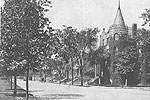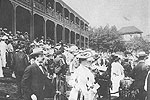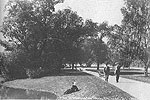
Grand Boulevard —
Washington Park (continued)
Washington Park
Whereas Grand Boulevard was nearly all built up by the turn of the century.
Washington Park experienced sporadic development. The first settlement
emerged in the 1870s as railroad workers purchased two-story frame homes
which had been built west of State Street and south of 51st Street. The
area's principal institution was St. Anne Church at Garfield Boulevard
(55th Street) and Wentworth, dedicated in 1880 (See Fig. 1).
This working-class district was a stable one, and St. Anne's pastor
attributed the prosperity of his parish to the fact that "a larger
number of its families own their own homes than is usual."
While the extension of the State Street car line to Englewood and the
completion of the "L" sparked residential construction north
of Garfield Boulevard, large tracts within Washington Park remained
prairie.
The Washington Park Club at the east end of the district had once been
the meeting place of Chicago's elite. But a betting scandal in 1894 closed
the track for three seasons, and the death knell
sounded in 1905 when city officials shuttered all Chicago race tracks
as a way to curb gambling (See Fig. 2 ). The Washington Park Club
disbanded and its putting greens were transplanted to South Shore where
they formed the
nucleus of South Shore Country Club's golf course.
Although the grounds of the old Washington Park Club and race track were
subdivided for apartments, the area retained its reputation as an entertainment
district (See Fig. 3). The same excellent
transportation facilities which had made the Washington Park Club so attractive
to Chicagoans also assured the success of similar ventures. The Sans
Souci Amusement Park, which opened in 1899 at 60th and Cottage Grove,
featured vaudeville shows, band concerts, electric gondola rides, an
arcade, an
electric fountain, a beer garden, and a Japanese tea garden. The admission
fee was ten cents, and the management boasted that, "Every attention
is paid ladies and children."
In 1914 a new entertainment complex designed by Frank Lloyd Wright was
constructed on the grounds of Sans Souci Park. Despite its elegant facilities
for music and dancing, however, the new Midway Gardens failed to catch
on as a performing arts center, and in 1916 it was sold to the Edelweiss
Beer Company. Its days as a drinking establishment were cut short by Prohibition
in 1920, and thereafter Midway Gardens operated as a garage and car wash
until it was razed in 1929.
«
previous
5
of 14
next
»
|
 |

|
 |
 
Figure
1: Garfield Boulevard (55th Street) looking west from Dearborn (Lafayette
Avenue), c. 1910. »

Figure
2: Washington Park Race Track, 61st and South Park (King Drive), c.
1900. »

Figure
3: Washington Park, c. 1908. »
|